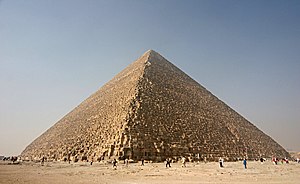
Back Groot Piramide van Giza Afrikaans የጊዛ ታላቅ ፒራሚድ Amharic الهرم الأكبر Arabic هرم خوفو ARZ Gran Pirámide de Guiza AST Xeops ehramı Azerbaijani جیزه هرمی AZB Хеопс пирамидаһы Bashkir Піраміда Хеопса Byelorussian Піраміда Хеопса BE-X-OLD
| Great Pyramid of Giza | |
|---|---|
 The Great Pyramid in March 2005 | |
| Khufu (Dynasty IV) | |
| Coordinates | 29°58′45″N 31°08′03″E / 29.97917°N 31.13417°E |
| Ancient name | |
| Architect | Hemiunu (presumed) |
| Constructed | c. 2600 BC (Old Kingdom) c. 4600 years ago |
| Type | True pyramid |
| Material | Limestone, mortar, granite |
| Height | Original: 146.6 m (481 ft) or 280 cubits Current: 138.5 m (454 ft) |
| Base | 230.33 m (756 ft) or 440 cubits |
| Volume | 2.6 million m3 (92 million cu ft) |
| Slope | 51°50'40" or seked of 5+1/2 palms[2] |
| Part of | Memphis and its Necropolis – the Pyramid Fields from Giza to Dahshur |
| Criteria | Cultural: i, iii, vi |
| Reference | 86-002 |
| Inscription | 1979 (3rd Session) |
| Area | Arab states |
|
Building details | |
 | |
| Record height | |
| Tallest in the world from c. 2600 BC to 1311 AD[I] | |
| Preceded by | Red Pyramid (Egypt) |
| Surpassed by | Lincoln Cathedral (England)[dubious – discuss] |
The Great Pyramid of Giza[a] is the largest Egyptian pyramid. It served as the tomb of pharaoh Khufu, who ruled during the Fourth Dynasty of the Old Kingdom. Built c. 2600 BC,[3] over a period of about 26 years,[4] the pyramid is the oldest of the Seven Wonders of the Ancient World, and the only wonder that has remained largely intact. It is the most famous monument of the Giza pyramid complex, which is part of the UNESCO World Heritage Site "Memphis and its Necropolis".[5] It is situated at the northeastern end of the line of the three main pyramids at Giza.
Initially standing at 146.6 metres (481 feet), the Great Pyramid was the world's tallest human-made structure for more than 3,800 years. Over time, most of the smooth white limestone casing was removed, which lowered the pyramid's height to the current 138.5 metres (454.4 ft); what is seen today is the underlying core structure. The base was measured to be about 230.3 metres (755.6 ft) square, giving a volume of roughly 2.6 million cubic metres (92 million cubic feet), which includes an internal hillock.[6] The dimensions of the pyramid were 280 royal cubits (146.7 m; 481.4 ft) high, a base length of 440 cubits (230.6 m; 756.4 ft), with a seked of 5+1/2 palms (a slope of 51°50'40").
The Great Pyramid was built by quarrying an estimated 2.3 million large blocks, weighing 6 million tonnes in total. The majority of the stones are not uniform in size or shape, and are only roughly dressed.[7] The outside layers were bound together by mortar. Primarily local limestone from the Giza Plateau was used for its construction. Other blocks were imported by boat on the Nile: white limestone from Tura for the casing, and blocks of granite from Aswan, weighing up to 80 tonnes, for the "King's Chamber" structure.[8]
There are three known chambers inside of the Great Pyramid. The lowest was cut into the bedrock, upon which the pyramid was built, but remained unfinished. The so-called[9] Queen's Chamber and King's Chamber, which contain a granite sarcophagus, are above ground, within the pyramid structure. Hemiunu, Khufu's vizier, is believed by some to be the architect of the Great Pyramid.[10] Many varying scientific and alternative hypotheses attempt to explain the exact construction techniques, but, as is the case for other such structures, there is no definite consensus.
The funerary complex around the pyramid consisted of two mortuary temples connected by a causeway (one close to the pyramid and one near the Nile); tombs for the immediate family and court of Khufu, including three smaller pyramids for Khufu's wives; an even smaller "satellite pyramid"; and five buried solar barques.
- ^ Verner (2001), p. 189.
- ^ Lehner 1997, p. 108.
- ^ Cite error: The named reference
Ramsey2010was invoked but never defined (see the help page). - ^ Tallet 2017, p. 160.
- ^ "Memphis and its Necropolis – the Pyramid Fields from Giza to Dahshur". UNESCO World Heritage Centre. United Nations Educational, Scientific, and Cultural Organization. Retrieved 7 September 2021.
- ^ Lehner & Hawass 2017, pp. 143, 530–531.
- ^ Lehner, Mark (2002). "The Fabric of a Pyramid: Ground Truth" (PDF). Aeragram. 5_2: 4–5. Archived (PDF) from the original on 2 April 2016.
- ^ Lehner 1997, p. 207.
- ^ Romer 2007, p. 8"By themselves, of course, none of these modern labels define the ancient purposes of the architecture they describe."
- ^ Shaw 2003, p. 89.
Cite error: There are <ref group=lower-alpha> tags or {{efn}} templates on this page, but the references will not show without a {{reflist|group=lower-alpha}} template or {{notelist}} template (see the help page).

